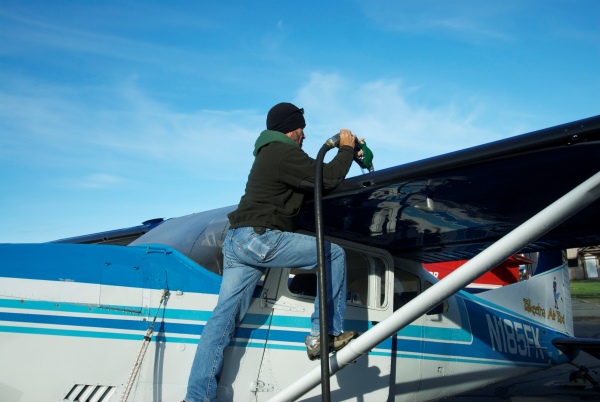
Photo: Brad Adams fueling a Talkeetna Air Taxi Cessna 185 last summer. When he’s not flying tourists and climbers around Mt. Denali, Brad works for a hunting/fishing lodge on the Alaskan Peninsula.
Scroll down for the audio interview!
Your fantasy of flying in Alaska probably includes big mountains, rough ridge-tops, and small planes. The truth is that most Alaska flying jobs involve hauling people and cargo from airport to airport. Soda pop and potato chips are a staple load, and the airports themselves have improved over the years. It’s still a challenging environment, but the reality of Alaskan flying may not match your romanticized vision of it.
That said, there are still some small bastions of the romantic version of bush flying out there. Especially if your vision includes plenty of hard work … and cleaning blood and guts out of your plane at night.
If you’re interested in real bush flying, you’ll like this interview.
Brad Adams and I both worked for Talkeetna Air Taxi last summer. We’d come from very different backgrounds. I’ll admit that I’m a little jealous of his choices. Most of his flying has been in a Super Cub, flying hunters around the Alaskan Peninsula southwest of Anchorage. This is the type of flying I fantasized about before I headed up north for the first time. There’s lots of autonomy flying your own plane in and out of gravel bars and ridge tops you choose. And there are lots of challenges flying in and out of a spot that the hunters chose for you close to the kill, with little concern for your aircraft’s capabilities). That kind of flying really tests your decision-making and flying skills.
Curious about how someone gets into this type of flying, once again I forced a co-worker to sit down and school me on the ins and outs of their flying job.
One interesting thing I learned from Brad is that you don’t need a commercial license to fly hunters out of a lodge in Alaska. There was some fuss about this just over ten years ago. I remember when it was being discussed, and had assumed that the FAA had made a commercial license mandatory. Evidently, they backed off this stance, and today a private license is all that’s required in most cases. The main requirement is related to hunting, not flying. You need a current Alaskan hunting license, and you need to have taken an animal in the last two years. From a practical standpoint, no lodge is going to hire you if you don’t understand the terrain that you will be flying over, or how to skin out a moose.
If you really like the outdoors and hunting and fishing, lodge flying jobs are great. As you’ll hear in the interview, they involve lots of good stick and rudder flying, working with hunting and fishing guides (in some cases being one yourself), and living in very nice, expensive lodges. Of course there’s lots of hard work too!
I recently ran into a pilot I used to work with in St. Mary’s, on the Yukon River. He flies floats for a lodge during the summer. Sometime soon I hope to chat with him, and get the float flying version of the Alaska lodge flying out of him for you.
In this interview you’ll hear about:
- How Brad started out his career in Alaska as a fishing and hunting guide, with no intention of becoming a pilot.
- How he moved into a flying career by accident (with a private license, and 500 hours of Alaska time in his own Supercub).
- How most hunting and fishing lodges hire pilots who are also licensed guides.
- The debate between lodges and the FAA in the 1990s regarding Part 91 vs. Part 135 regulations.
- Whether an instrument rating is useful for this sort of flying.
- What a typical day is like for a pilot/guide.
- The living conditions at the lodge.
- How the pilots ferry fuel for the lodge in a Beaver.
- How flying for a lodge differs from flying for an air taxi company (especially when the weather’s bad and you can’t go flying).
- When the hunting and fishing seasons start and end.
- The financial challenges of seasonal flying work.
- Why a Piper Supercub is the best bush plane for most guiding.
- How to choose a safe area to land off-airport in the bush.
- Why most bush accidents or incidents hurt the airplanes … but not the people.
- How to transition to off-airport flying.
- Why it’s so humbling to be a pilot in Alaska.
- Brad’s advice for you if you want to fly for a lodge.
- How to become a hunting guide in Alaska.
- Why working for a lodge is generally not the job for you if all you want to do is fly!
Interview
Press the Play icon to begin streaming the audio, or right-click the text link and choose Save As or Save Link.
[audio: brad_adams_interview.mp3]Right-click to download the MP3 file (38 minutes – 34 MB)
Did you like this interview? Leave your comments and questions below!
Videos
Some great videos that will give you some insight into the flying, the job, and the lodge:
Flight Simulation
Want to fly some virtual hunters around Alaska? Mike recommends these add-ons for Microsoft Flight Simulator X:
Aircraft
Scenery

Great interview Bradley!
I have personally seen him do some amazing things in an airplane. Brad, I know you would never say this but after all these years you must agree, there are maybe some great pilots in Alaska but you are one of them.